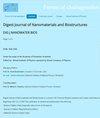Application of pani/metal oxide composite as an active material of liquified petroleum gas sensors
IF 1.3
4区 材料科学
Q4 MATERIALS SCIENCE, MULTIDISCIPLINARY
Digest Journal of Nanomaterials and Biostructures
Pub Date : 2023-04-01
DOI:10.15251/djnb.2023.182.485
引用次数: 0
Abstract
Polyaniline (PANI) and metal oxides are two materials that have various applications, including active sensors. PANI provides several benefits over other conductive polymers, including ease of synthesis, affordability, and high conductivity. Depending on the benefits of PANI, here we report the fabrication of PANI/metal oxide composites as an active material for gas sensors, especially LPG. By oxidatively polymerizing aniline at room temperature, PANI was formed. PANI/metal oxide composites were produced by using an in-situ polymerization technique. The PANI/MgO and PANI/ZnO nanocomposites were successfully fabricated, as shown by FTIR and XRD characterization results. The sensitivity of PANI/metal oxide nanocomposites to LPG has been proven. The result shows that PANI/metal oxide sensitivity is better than barePANI/MgO, which is one of the kinds of metal oxide used. Several concentrations of gas were used at low ppm: 50, 100, and 200 ppm to identify the sensitivity of PANI. The size of the pores with a radius of 285 Ă of the PANI/MgO nanocomposite shows that the value sensitivity was improved. The PANI/MgO nanocomposite has the best sensitivity to LPG exposure because it works well at all concentrations.聚苯胺/金属氧化物复合材料作为液化石油气传感器活性材料的应用
聚苯胺(PANI)和金属氧化物是两种具有各种应用的材料,包括有源传感器。与其他导电聚合物相比,PANI提供了几个优点,包括易于合成、可负担性和高导电性。根据聚苯胺的优点,我们在这里报道了聚苯胺/金属氧化物复合材料作为气体传感器,特别是液化石油气传感器的活性材料的制备。苯胺在室温下氧化聚合,形成聚苯胺。采用原位聚合技术制备了聚苯胺/金属氧化物复合材料。FTIR和XRD表征结果表明,成功制备了PANI/MgO和PANI/ZnO纳米复合材料。PANI/金属氧化物纳米复合材料对LPG的敏感性已经得到证实。结果表明,PANI/金属氧化物的灵敏度优于所用金属氧化物中的barePANI/MgO。在低ppm下使用几种浓度的气体:50、100和200ppm,以确定PANI的敏感性。PANI/MgO纳米复合材料的孔径为285Ă,表明其数值敏感性得到了提高。PANI/MgO纳米复合材料对LPG暴露具有最好的敏感性,因为它在所有浓度下都能很好地工作。
本文章由计算机程序翻译,如有差异,请以英文原文为准。
求助全文
约1分钟内获得全文
求助全文
来源期刊

Digest Journal of Nanomaterials and Biostructures
工程技术-材料科学:综合
CiteScore
1.50
自引率
22.20%
发文量
116
审稿时长
4.3 months
期刊介绍:
Under the aegis of the Academy of Romanian Scientists
Edited by: -Virtual Institute of Physics operated by Virtual Company of Physics.
 求助内容:
求助内容: 应助结果提醒方式:
应助结果提醒方式:


